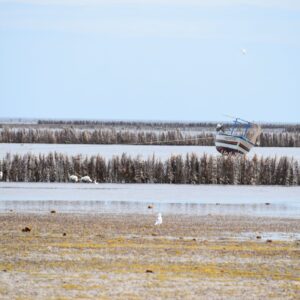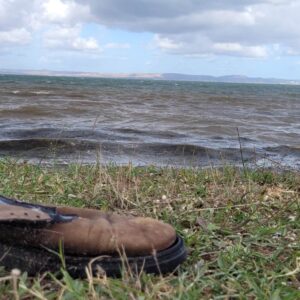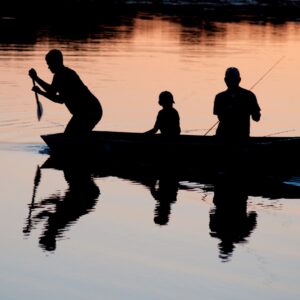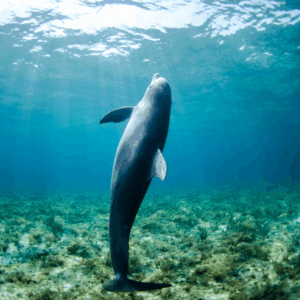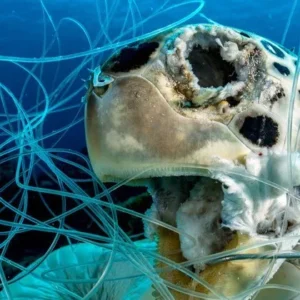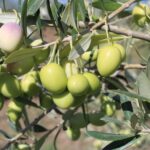Under the sea surface lie secrets and stories of species engaged in a struggle for survival while serving as protectors of the sea’s delicate balance. Among these stories stands the Mediterranean’s exceptional defender, Pinna Nobilis, the world’s second-largest bivalve, locally called “Garn Hrich” Despite its unassuming nature, this remarkable creature symbolizes nature’s heroism, working ceaselessly to maintain the sea’s harmony and vitality. In light of its essential role, Pinna nobilis is confronted by an array of threats that imperil its very existence. Mainly, a mass mortality event unfolded in the southwestern Mediterranean in 2016, leading to mortality rates as high as 80% to 100%. This issue is escalating, presently impacting the Pinna nobilis populations on the coastlines of Tunisia.
Tunis, August 2023
Discovering Pinna nobilis: The Mediterranean’s largest seashell
The distinguished pen shell, Pinna nobilis, stands as an iconic and indigenous species within the Mediterranean Sea. It claims the title of the Mediterranean’s largest seashell and the world’s second-largest overall, it comes second only to the giant clam, Tridacna gigas, with its shell extending up to an impressive 1.2 meters. This remarkable species is commonly found vertically embedded, utilizing its byssus threads to anchor itself firmly, penetrating soft substrates like mud, sand, or gravel, often reaching a depth of up to one-third of its height. Based on statements of Malek Azzabi, a Tunisian engineer specializing in fisheries and environmental sciences, embarked on her research journey by delving into the study of this iconic species, Pinna nobilis, or the Mediterranean breather, as she prefers to call it, thrives along the entire Tunisian coastline, from north to south, inhabiting both marine and lagoon environments. This remarkable species predominantly resides in sandy-muddy or sandy substrates, with its primary habitat being within the seagrass meadows. Malek’s investigations confirmed the previous studies revealing its presence in the meadows of Cymodocea Nodosa and Caulerpa prolifera.
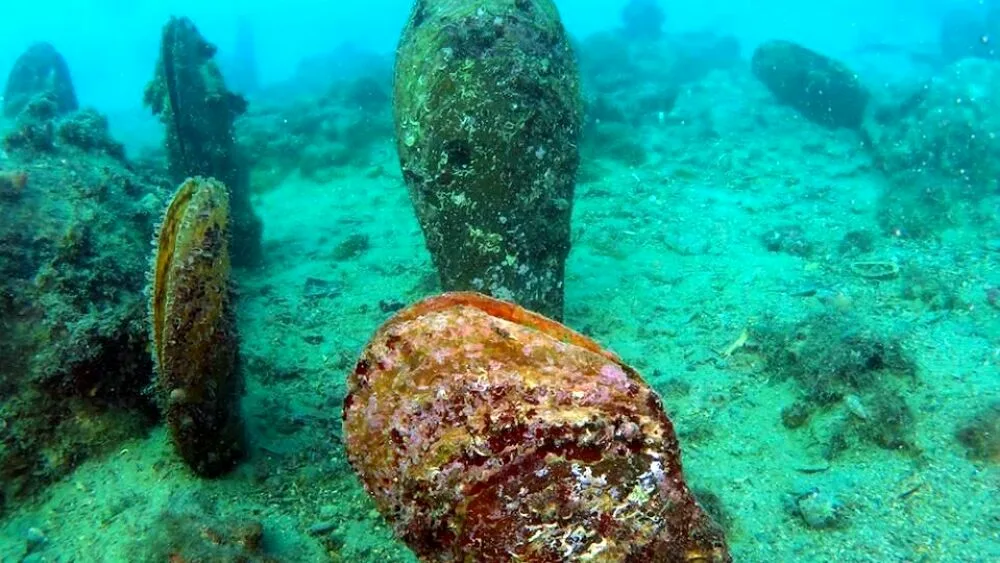
“This special shell prefers to make its home in calm lagoons and it prefers the shallower parts of the water. Pinna nobilis prefers sheltered lagoon environments and is abundant in shallow waters. According to local fishermen, during the 1980s and 1990s, it was widely found in areas with high population density. Notable locations include the Bizerte Lagoon, Ghar El Melh Lagoon, Monastir Bay, Kerkennah Island, Djerba Island, specifically Rass Rmal, the Boughrara Lagoon, and Biben lagoon area near El Ketef. These were particularly favored habitats for Pinna nobilis. ” Declares M.Azzabi
Echoes of 2016: The catastrophic loss of Pinna nobilis
According to the Centre for Regional Activities for Specially Protected Areas (RAC/SPA), the year 2016 witnessed a significant event in the Mediterranean that brought dire consequences for the populations of Pinna nobilis and caused mortality rates to surge to levels between 80% and 100%. This occurrence led to a distressing decline and extensive mortality of these creatures. This crisis was triggered by the protozoan Haplosporidium pinnae, a pathogenic microorganism that affects the mollusk’s digestive system, initially being attributed as the primary cause of mortality. Referring to the same source, recent investigations point to the involvement of diverse bacterial species. This hints at the possibility of a multifactorial ailment being responsible for the extensive mortality observed.
Regrettably, in 2016, a parasitic epidemic triggered substantial mortality within this species. Presently, there remains limited data and documentation regarding the current status of Pinna nobilis in Tunisia. Nevertheless, based on scientific research, fishermen’s reports, and field surveys, it has been indicated that this species still persists in the Kerkennah Islands, El Bibene Lagoon, and El Ketef Ben Guerdene. We hold hope for the revelation of additional sites harboring viable Pinna populations.
M.Azzabi
In a study titled “The Fan Mussel Pinna nobilis on the Brink of Extinction in the Mediterranean,” conducted by marine ecology researcher Stelios Katsanevakis, who is a professor at the University of the Aegean in Greece, alarming findings have come to light. Starting from 2016, the majestic P. nobilis has been facing a grave threat. Currently, the surviving fan mussel populations are confined to a few scattered lagoons or enclosed bays. The figure illustrated in the study provides an overview of the recent condition, as of November 2020, of Pinna nobilis populations within the Mediterranean Sea post the parasitic outbreak of 2016. Regions of the coastline lacking color representation signify areas where the situation remains uncertain. For the coastal stretch of Tunisia where mortality is less than 35%, the figure illustrates that resilient live populations are still persisting and remaining viable.
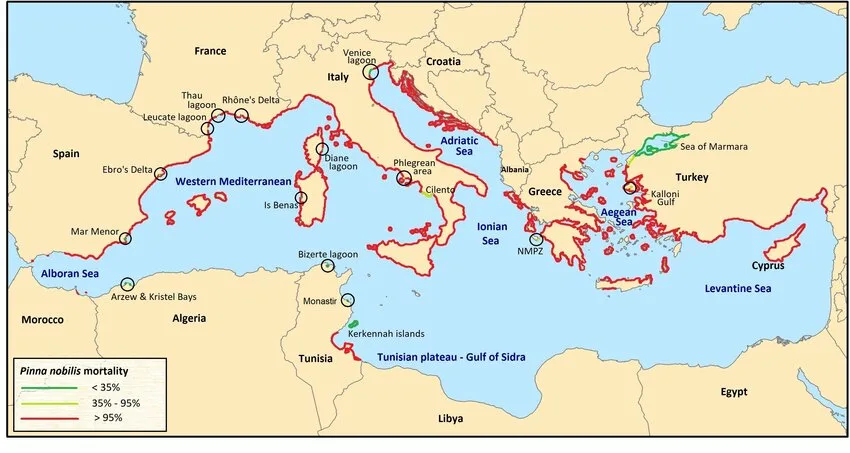
Protecting Pinna nobilis: Conservation status
Pinna nobilis holds a significant conservation status. It is listed in Annex II of the Protocol for specially protected areas and biodiversity within the Barcelona Convention. Notably, figured in the IUCN Red List classified this species as critically endangered (CR) in 2019. This critical status stems from an ongoing significant reduction in its population caused by the mass mortality event that is still threatening the species populations in the Mediterranean. Moreover, Pinna nobilis is recognized as a species of community interest, warranting strict protection under the European Habitats Directive (92/43/EEC). These frameworks have been implemented to address the pressing challenges confronting the species, which in turn elevates awareness and provides essential legal protection. The intent is not only focused on safeguarding the species from extinction but also extends toward revitalizing its population to more resilient and sustainable levels.
The vital ecological role of Pinna Nobilis
As per the International Union for Conservation of Nature (IUCN), Pinna nobilis holds a pivotal ecological role by effectively filtering water and retaining significant amounts of organic matter from suspended debris. This process contributes substantively to water clarity. Its distinctive characteristics draw numerous divers from across the Mediterranean.
Regarding the Pinna species, an individual has the capacity to filter approximately 6.5 to 10 liters of water per day, thus playing a role in upholding a degree of clarity within its habitat.”
Salma Zribi, a PhD candidate in marine ecology.
Based on her statements, it serves as a bioindicator of the quality of both the seabed and water in the Mediterranean coastal region. Its sensitivity to pollutants makes its presence indicative of the overall health of the coastal marine ecosystem, signifying a favorable state. According to Malek Azzabi, Pinna nobilis holds the status of a “keystone species”, it serves as a habitat for numerous other species, with scientists having identified 146 species so far and it also establishes a habitat complex by forming underwater meadows. These meadows provide shelter and protection for numerous other marine species.
The shell provides a substrate for various organisms to settle on its valves. These epibionts form a miniature ecosystem that reflects the local biodiversity, including sponges, bryozoans, algae, ascidians, hydroids, mollusks, and more.
Salma Zribi
Beyond the epizootic event: Multifaceted endangerment of Pinna nobilis
According to Salma Zribi, in addition to the epizootic event that severely impacted Pinna nobilis, the noble pen shell faces further endangerment from a range of factors. These include the rampant illegal harvesting of mature specimens. Beyond the significant blow dealt by the epizootic event, are both multifaceted and pressing. Among these challenges, the perilous state of Pinna nobilis is exacerbated by the rampant and unlawful extraction of mature specimens, an activity that threatens to decimate its populations. Additionally, the gradual and troubling regression of seagrass meadows, which serve as vital habitats, intensifies the species’ vulnerability. Furthermore, the increasing pollution of marine environments worsens the species’ situation, dimming its chances of recovery. Equally troubling is the release of untreated wastewater, which harms the water quality and destroys young noble pen shells.
One of the main threats of P. nobilis is the destruction and degradation of coastal habitats due to the anchoring of fishing boats, particularly through methods like bottom trawling, pose a significant threat to the presence of Pinna nobilis.
M.Azzabi
Restoring marine treasure: Tunisia’s Pinna nobilis conservation initiatives
In Tunisia, conservation and management measures have been established to safeguard the Pinna nobilis. According to Malek Azzabi, in 2018 as part of the management of protected marine and coastal areas and in response to the significant mortality of the bivalve Pinna nobilis, the Coastal Protection and Planning Agency (APAL), in collaboration with the International Union for Conservation of Nature (IUCN) and SPA/RAC, devised a plan to establish a monitoring and surveillance network for Pinna nobilis populations in Tunisia. By 2022, the adoption and implementation of a restoration program for the Noble Pen Shell in the Mediterranean, aimed at rejuvenating its population, are in progress.
Synergizing for conservation: Scientific research and civil society’s impact
Scientific research holds immense importance in ensuring the restoration and conservation of Pinna nobilis in Tunisia, as emphasized by Salma Zribi. The scientific contribution is integral to the preservation of the noble pen shell, discussions surrounding protective measures or stock restoration of this iconic species are incomplete without the foundation of scientific research.
“These studies delve into Pinna’s habitat, feeding behavior, interactions with other species, and its ecosystem impact. Additionally, scientific research aids in identifying stressors and threats facing the species, crucially identifying the presence of the pathogen responsible for its massive mortality. Research on pathogens and vectors involves an in-depth exploration of the origin, and epizootic dynamics to devise means of disease mitigation, understanding its longevity, and curbing its spread along our coastline.” Reveals M.Azzabi
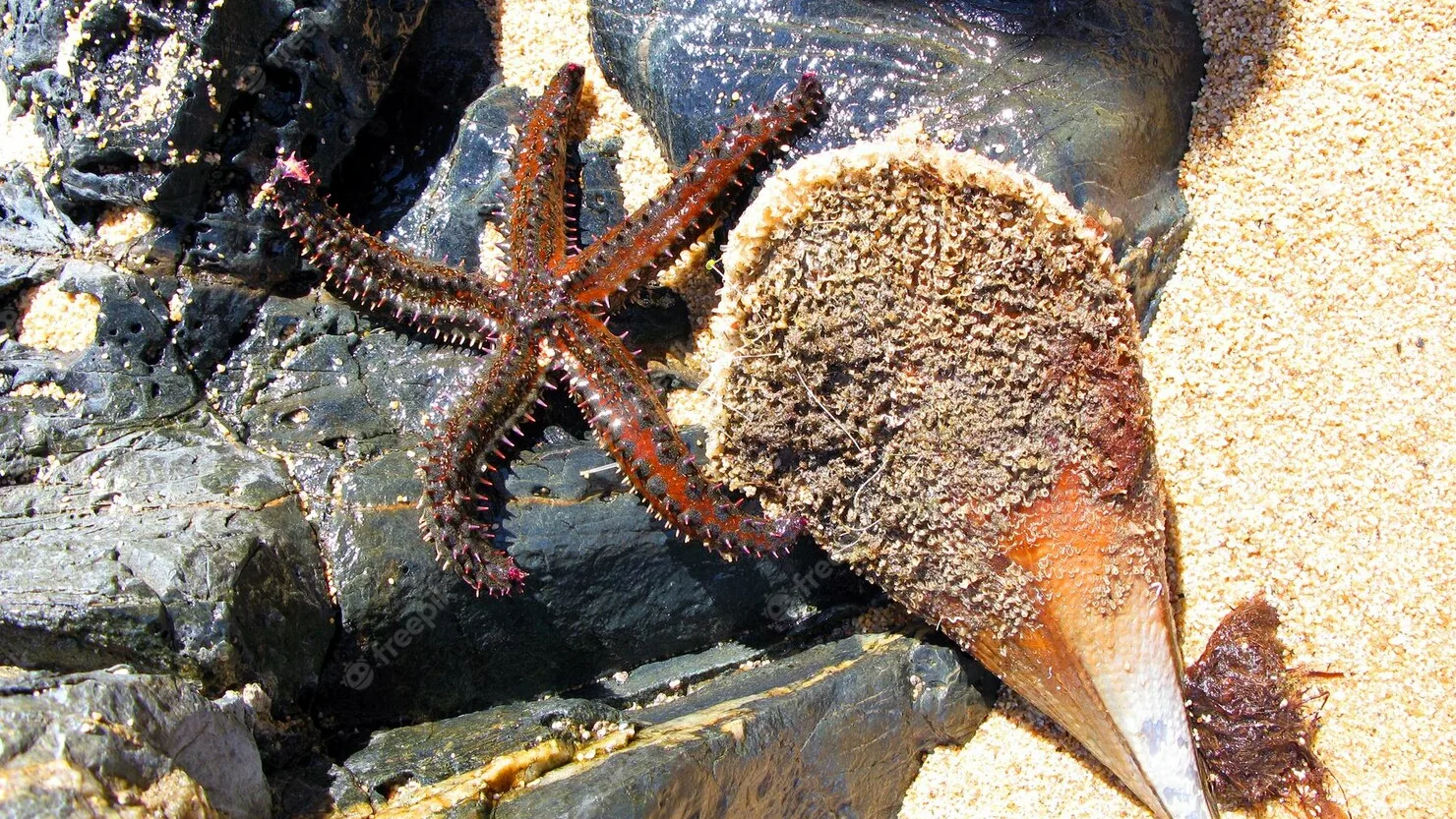
In accordance with Malek Azzabi’s statement, working hand in hand with civil society and non-governmental organizations play a crucial role in not only managing habitats but also devising habitat management strategies to guarantee the health and prosperity of the regions inhabited by Pinna nobilis. “Numerous initiatives carried out by Tunisian associations, including notable efforts by AJEM Jelij Djerba, have yielded substantial impact and tangible transformation. These initiatives encompass conducting awareness campaigns within port communities of fishermen, focusing on the status of Pinna nobilis. Furthermore, they have orchestrated exploratory excursions to substantiate the species’ presence, as prominently emphasized.” Declared Malek.
” In response to the drastic decline in noble pen shell populations, the ATUTAX (Tunisian Association of Taxonomy) has initiated a project titled “Ecological Restoration for the Conservation of Heritage Species in the Kerkennah Archipelago (PP-KER). Within the framework of this project, a participatory approach is employed, involving civil society actors such as fishermen, artisans, local associations, and the private sector. It aims to familiarize the general public with the noble pen shell, its significance within the marine ecosystem, and the protective measures that can be adopted to safeguard this endemic and endangered bivalve population.” Decalres Salma Zribi.
Pinna nobilis SOS: Ways of preservation
According to Malek Azzabi, expediting the monitoring and surveillance of coastal populations in Tunisia is imperative. There is an active need to identify areas where Pinna nobilis is present as, without swift action, the existence of these noble pen shells could be imperiled in the near future. It is essential to intensify awareness campaigns and public outreach efforts, aimed at highlighting the pivotal role of Pinna nobilis conservation. Furthermore, reinforcing existing legislation and regulations concerning the protection of Pinna nobilis is of paramount importance. “Witnessing the uplifting influence on the local populace, fishermen, and divers as they become sensitized to the protection of Pinna nobilis is truly inspiring. This transformation drives them to increase their involvement, eagerly seeking to interact further in its preservation. They are keen on sharing innovative solutions and participating in initiatives that contribute to its safeguarding.” Concludes M.Azzabi
“Taking the example of awareness workshops and training centered on the significance and protective measures for the noble pen shell, particularly targeted at local communities such as fishermen, associations, and students, a noticeable enhancement in local awareness has been observed. This underscores the potent impact of awareness initiatives on the local population, as they have begun actively engaging in the conservation efforts for this species.” Reveals Salma Zribi
The path ahead remains a collective endeavor, uniting individuals and stakeholders alike in the fight to preserve this iconic species that holds immense significance in the Mediterranean.
This article was developed in collaboration with the Earth Journalism Mediterranean Initiative Media project.
Copyright © 2023 Blue Tunisia. All rights reserved
Sources:
- https://www.researchgate.net/publication/351974726_The_Fan_Mussel_Pinna_nobilis_on_the_Brink_of_Extinction_in_the_Mediterranean
- https://www.facebook.com/SPARACinfos/videos/2034681720025795
- https://theses.hal.science/tel-03728197/file/PEYRAN_Claire_2021.pdf
- https://www.rac-spa.org/node/2231
- https://www.iucn.org/fr/news/mediterranean/201907/crise-de-la-grande-nacre-en-mediterranee-pinna-nobilis-mise-a-jour-janvier-2021#:~:text=La%20Grande%20Nacre%20de%20la%20M%C3%A9diterran%C3%A9e%20%2D%20Pinna%20Nobilis%20%2D%20inscrite%20sur,d’extinction%20%C2%BB%20(CR)
- https://www.rac-spa.org/sites/default/files/annex/annex_2_en_20182.pdf
- https://eur-lex.europa.eu/legal-content/EN/TXT/PDF/?uri=CELEX:31992L0043
- https://www.iucn.org/sites/default/files/content/documents/2021/grande_nacre_uicn_mediterranee.pdf
- https://www.instm-bulletin.tn/index.php/bulletin/article/view/543/344
